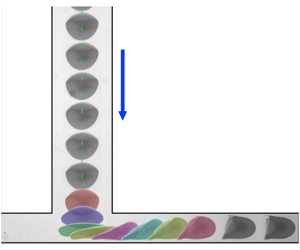Article contents
Deformation and sorting of capsules in a T-junction
Published online by Cambridge University Press: 17 December 2019
Abstract

We study experimentally the motion and deformation of individual capsules transported by a constant volume-flux flow of low Reynolds number, through the T-junction of a channel with rectangular cross-section. We use millimetric ovalbumin-alginate capsules which we characterise independently of the flow experiment. Centred capsules travel at constant velocity down the straight channel leading to the T-junction, where they decelerate and expand in the spanwise direction before turning into one of the two identical daughter channels. There, non-inertial lift forces act to re-centre them and relax their shape until they reach a steady state of propagation. We find that the dynamics of fixed-size capsules within our channel geometry is governed by a capillary number  $Ca$ defined as the ratio of viscous shear forces to elastic restoring forces, which we quantify by statically compressing the capsule between parallel plates to 50 % of its initial diameter, in order to account for different membrane thickness, pre-inflation and nonlinear elastic deformation. We show that the maximum extension in the T-junction of capsules of different stiffness collapses onto a master curve in
$Ca$ defined as the ratio of viscous shear forces to elastic restoring forces, which we quantify by statically compressing the capsule between parallel plates to 50 % of its initial diameter, in order to account for different membrane thickness, pre-inflation and nonlinear elastic deformation. We show that the maximum extension in the T-junction of capsules of different stiffness collapses onto a master curve in  $Ca$. This provides a sensitive measure of the relative stiffness of capsules at constant flow rate, particularly for softer capsules. We also find that the T-junction can sort fixed-size capsules according to their stiffness because the position in the T-junction from which capsules are entrained into the daughter channel depends uniquely on
$Ca$. This provides a sensitive measure of the relative stiffness of capsules at constant flow rate, particularly for softer capsules. We also find that the T-junction can sort fixed-size capsules according to their stiffness because the position in the T-junction from which capsules are entrained into the daughter channel depends uniquely on  $Ca$. We demonstrate that a T-junction can be used as a sorting device by enhancing this initial capsule separation through a diffuser.
$Ca$. We demonstrate that a T-junction can be used as a sorting device by enhancing this initial capsule separation through a diffuser.
- Type
- JFM Papers
- Information
- Copyright
- © 2019 Cambridge University Press
References
- 15
- Cited by


